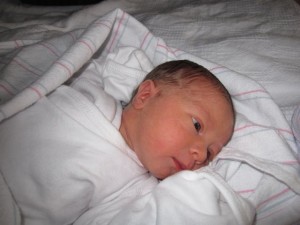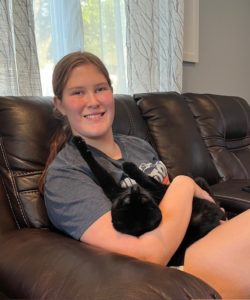On December 2, 2008, we had the pleasure of meeting the most beautiful girl in the whole world – Sophia Jay. She was healthy and perfect, with ten fingers and ten toes. We thought nothing of the routine blood tests that the nurse wheeled her away to take. This perfect little person was the epitome of a healthy baby; we never suspected we had anything to worry about.
We brought Sophia home two days later with our biggest concern being the drive home in the snow. We got settled and let it sink in that we were now responsible for someone else’s well being besides our own. How were we going to know how to feed her, change her, burp her … get her in and out of the car … manipulate her stroller? This was all complicated stuff for first time parents!
A day after we got home, Sophia was becoming increasingly irritable. We walked with her as she cried and cried, joking that this was what having a baby was all about. During this time, we received a call from our pediatrician’s office. The doctor on the other end, whom we had never met, awkwardly told us that they received a call from the newborn screening board and that something may be wrong with our perfect child. It was something that he had only seen “once in 40 years” and could be life-threatening. However, they were going to analyze the test further and call back in the morning.
After a long, sleepless night, we received another call that we needed to get to the hospital immediately for further blood work. No one could tell us anything, including the staff in the ER, upon arrival. After what seemed like an eternity, a metabolic physician arrived to explain what was happening. Our entire world fell in around us, as we learned that Sophia was born with a rare metabolic disorder called Argininosuccinic Aciduria (a urea cycle disorder) which affects 1 in 85,000 babies. Her little body is missing an enzyme which is crucial in the functioning of the urea cycle. Without this enzyme, she is unable to flush out the toxic by-product of protein metabolism – ammonia.
She was started on rescue medication late that night and responded as we all hoped she would. After a week of living in the ICU, we took our baby home – again. We set about learning how to care for her in a way we never expected – ordering special formulas, learning to administer medication, tracking protein grams consumed each day. We were followed weekly by our metabolic team in Boston. All of our normal “new parent” concerns took a backseat and we learned to cherish what is truly important in life – the health of our baby girl.
In 2013, Sophia was listed for a liver transplant at the recommendation of her physicians. Her liver had become extremely enlarged and was compromising the function of her other organs. A match was found and she received her new liver on November 16, 2013. She has done extremely well so far and we pray that her body will continue to accept her new liver as time goes on. She is now 15 years old and in 9th grade.
Every day, we thank God that Sophia was born in a state that screened for this extremely rare condition. Shortly after Sophia was born, screening for ASA became mandatory in every state, but at that time, it was optional. Saving even just one baby’s life makes it worthwhile in our eyes. Catching a problem in time can determine whether a child can go on to lead a healthy, productive life. Sophia was diagnosed before she fell into a coma or suffered major brain injury, but others are not as lucky.
We have faced many challenges together and there will be many more to come, but we will continue to deal with each as a family. We are honored to be Sophia’s parents and to watch her grow into the loving, beautiful, confident person that she is becoming.
You never know how strong you are until being strong is the only choice you have.




